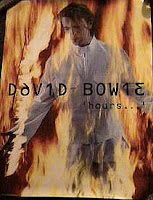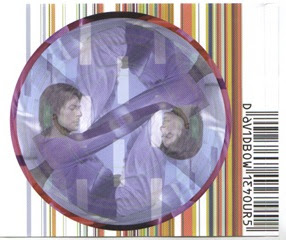The Legend is now complete. The story has been told, its ending could not have been more perfectly constructed or executed. It’s said that the great ones know when to leave the stage; the Greatest also know how.
A little less than three years ago, David Bowie released what I called “The Last Rock ‘n’ Roll Album,” and pulled off what some critics labeled the greatest comeback since Elvis in ’68. Hardcore Bowie fans like myself were a bit nonplussed by the critical response to The Next Day, not because we didn’t appreciate the praise but because we wondered where these critics had been hiding while Bowie had been making important music both onstage (The BBC Radio Concert, the A Reality DVD, for starters) and in the studio (see 1.Outside, Earthling, Heathen).
But The Next Day was a landmark in that no one expected ever to hear from Bowie again, not after he suffered a coronary event onstage in 2004 that preceded a very long and troubling silence. No one certainly expected him to return with an album filled with top rank material designed to serve as an endpiece to the pop/rock phase of Bowie’s career.
Fewer still expected him to follow that up with Blackstar, an experimental set of jazz-inflected postrock designed to serve as his epitaph.
That he had also been working on a theatrical sequel to The Man Who Fell to Earth (currently enjoying a sellout run in New York) at the same time as recording Blackstar while dying of cancer can only add to the legend, of a man not-quite-human, but something more than you or I.
What can and must be said is that Bowie runs through the lifeblood of this blog and all the other work I’ve done. That’s no surprise to longtime readers.
I can still remember the effect hearing “Fame” had on my young mind, how it seemed like a transmission from a far stranger world, a world I wanted to go to. Soon enough I was reading the Time Magazine review of The Man Who Fell to Earth and realizing that this Bowie thing was a completely different type of phenomena, one I best pay close attention to (yeah, I was a weird nine year-old). The effect was only cemented by ‘Golden Years’ and ‘Sound and Vision’, which stood out like holographic intruders on the old daguerreotype of the AM radio Top 40 wasteland.
Of course, now my shelves are now filled with Bowie biographies but then I had no idea how utterly alien this man was, how these albums that redefined the course of popular music seem to burst fully formed from his fevered brain to the literal astonishment of his collaborators.
How he spent countless hours immersed in his occult library, or skywatching for UFOs, all the while painting, writing in his journals, studying dance or boxing and later, appearing in more films than most professional actors, until such time as it came to lay down another indelible classic.
It’s not a stretch to say that music was being channeled through him.
It wouldn’t be until 1978 that I’d really immerse myself in his Mysteries, and by the golden locks of Apollo, what a time it was to do so. I can still remember buying Stage at Jason’s Music and Luggage (!), which seems unloved today but for me was like finally stepping into that parallel dimension (I should add that I was on my way home from theatre class at the time, having briefly humored acting fantasies).
It was here I’d be initiated into the Mysteries of Sound that so bewitched Philip K Dick, Bowie and Eno’s synth-driven symphonettes from Low and Heroes. Dick was so enraptured by this music he saw it as some kind of alien transmissions converted to vinyl through a kind of modern electronic alchemy.
Bowie and The Man Who Fell to Earth had such a powerful effect on Dick’s emerging Gnostic awakening that they became major players in the first allegorical exegesis of his spiritual journey, Valis (the film within the novel was based on Dick’s experience of seeing Earth for the first time and how it seemed to resonate so completely with his own inner turmoil).
Not long after I ended up with an eight-track tape of Hunky Dory and not long after that Lodger was released. All of a sudden the hand-me-down rock stars of the 60s and 70s seemed irrelevant, counter-revolutionary, even. There was a dividing line now, it was Year Zero. Punk, Postpunk, New Wave and the rest were the new vanguard, the Great Wheel had turned. Only Bowie and his fellow travelers (Fripp, Eno, Iggy, etc) would seem relevant in the new regime.
But Bowie had other plans. He’d released his now-legendary string of classic albums under constant threat of financial insolvency (the great Spiders from Mars lineup was broken up because of financial pressures), thanks in large part to the drain on his accounts by his management team, who burned through his profits either with their endless partying and extravagance or by trying to launch hopeless careers.
He’d seen a new generation of artists getting rich off of his ideas and now he wanted to cash in. During the sessions for “Under Pressure”, Queen sold Bowie on the benefits he could reap by dumping the moribund RCA for the ravenous EMI, who’d made plutocrats out of the glam foursome.
With an eye on the success the Rolling Stones and The Police were having touring large stadiums, Bowie set his sights on American superstardom. His sexuality underwent public revision, with Bowie now claiming to have been a “closet heterosexual.”* He entered the studio with Chic mastermind Nile Rodgers and a new backing band which included rising star Stevie Ray Vaughn on guitar. The result was Let’s Dance, a bonafide blockbuster that finally put Bowie in the top rank where he and his fans felt he belonged.
Oh, but the price to pay.
A massive tour was planned which saw Bowie playing American football stadiums and making sure he gave fans every penny’s worth of entertainment. I saw Bowie on this tour and while it was an amazing show- one of the best I’d ever seen- it also felt like something had changed. This was no longer my Bowie, it was someone else. A lot of fans felt that way.
Suspicions were not dissuaded when Bowie rushed out Tonight which featured two bonafide classics (‘Blue Jean’, ‘Loving the Alien’) and a whole lot of filler (admittedly, Let’s Dance had its share of filler too).
Signs that Bowie was as bored with his new role as his 70s fans were were confirmed by a long (for the time) post-Tonight silence punctuated only by a few weak soundtrack numbers.
He re-emerged in 1987 with Never Let Me Down, an album that tried too hard to recapture Let’s Dance’s formula and buried a lot of worthy songs in the histrionic production techniques of the time. He compounded the felony with the Glass Spider tour, a half-hearted return to the theatricality of the Diamond Dogs era, only without the zeitgeist and with 75% more cringe. Plus, Peter Frampton?
Sensing he’d made all the wrong moves he tried to right the ship. He did a bare-bones greatest hits tour in 1990 (I saw that one too) but the backing band (aside from King Crimson frontman Adrian Belew) wasn’t up to the job.
He then hooked up with Iggy’s old rhythm section (the Sales brothers, as in Soupy) and new guitarist Reeves Gabrels for Tin Machine, but it looked and sounded like an overwrought midlife crisis. A reunion with Nile Rodgers seemed promising, but then his new record company went bankrupt as soon as Black Tie White Noise was released.
INTERLUDE: ‘I’ve been interested in the Gnostics.’
“Now the archon who is weak has three names. The first name is Yaltabaoth, the second is Saklas, and the third is Samael. And he is impious in his arrogance which is in him. For he said, `I am God and there is no other God beside me,’ for he is ignorant of his strength, the place from which he had come…” —THE APOCRYPHON OF JOHN
“Opening his eyes he saw a vast quantity of matter without limit; and he became arrogant, saying, `It is I who am God, and there is none other apart from me.’
“When he said this, he sinned against the entirety. And a voice came forth from above the realm of absolute power, saying, `You are mistaken, Samael’ – which is, `god of the blind.'” —THE HYPOSTASIS OF THE ARCHONS.
It wouldn’t be until Bowie abandoned his grasping for the mainstream and got his freak back on that he’d rediscover his Bowieness. A soundtrack for the British indie film The Buddha of Suburbia got Eno’s attention again and they took to the studio to record 1.Outside, a sprawling, deliciously-pretentious slab of 200-proof Bowie, replete with a ludicrous “concept” based on transgressive art, millennial angst and ritual murder.
The planned-for trilogy never materialized as Eno continued his career as megahit-making producer so Bowie returned with Earthling, where then-trendy dance music dribblings were grafted onto classic Bowie melodies. Luckily, most of the songs survive the procedure.
This was a favorite Bowie period for me, since he was just successful enough to be visible but not so much as to be annoyingly ubiquitous. His band, with Zach Alford on drums, Gail Ann Dorsey on bass and vocals, longtime keyboardist Mike Garson and guitarist Gabrels were hard, polished and just artsy enough to be interesting.
Unfortunately, it kind of came to a thudding halt in 1999 when Bowie’s mersh instincts (or record company pressure) got the better (or worse) of him again and …hours was released, an attempt to appeal to the then-burgeoning adult alternative contemporary or whatever the hell it was called market. Gabrels wasn’t having any of it and split. Fantastic CD artwork though.
Bowie played around with a few ideas- a Pin-Ups 2, remakes of his 60s songs- before cutting Heathen (2002) with Tony Visconti, the producer of his late 70s classics. Because of the realities of the new market or simple maturity, Bowie dropped the attempts to appeal to the dissipating younger market and made a classic Bowie album, a return to old-fashioned songcraft without any trendy bells and whistles. A new and larger band was assembled and Bowie began touring and doing various media appearances.
The effect of Heathen was mitigated by the followup Reality (2003), which in fairness may have been recorded to secure tour financing. A live DVD of the marathon Reality tour bolsters that suspicion but unfortunately the stress of the road on the 56-year old performer resulted in the aforementioned coronary event, leading us back to the long radio silence.
Of course, part of Bowie’s mystique is his lifelong immersion in the Occult. OTO member Peter Koenig first explored this in a highly subjective and rambling essay called The Laughing Gnostic (which I first read back in the old USENET days) and has been continually updated ever since. It touches on Bowie’s repeated use of catchwords and imagery taken from occult orders like the Golden Dawn as well as his cocaine-fueled obsession with Fascism in the mid-70s.
Bowie himself has always been cagey about his occult interests, preferring to keep an aura of uncertainty and mystery (much like his contemporary Jimmy Page, with whom he shares a birthday). All of this mystery and play will become very important shortly.
From 1997:
So were you involved in actual devil worship?
“Not devil worship, no, it was pure straighforward, old–fashioned magic.”
The Aleister Crowley variety?
“No, I always thought Crowley was a charlatan. But there was a guy called [Arthur] Edward Waite who was terribly important to me at the time. And another called Dion Fortune who wrote a book called ‘Psychic Self–Defence’. You had to run around the room getting bits of string and old crayons and draw funny things on the wall, and I took it all most seriously, ha ha ha ! I drew gateways into different dimensions, and I’m quite sure that , for myself, I really walked into other worlds. I drew things on walls and just walked trough them, and saw what was on the other side!”
For those who don’t know already, Waite is not only the man behind the definitive Tarot (as well as the author of The Pictorial Key to the Tarot), he also wrote a number of influential magical texts, many of which are still in print.
|
The Man Who Fell to Earth was science fiction but one has to wonder how exactly an alien come down to Earth would operate in the real world. Given the immense stellar distances, he might not travel physically but through some form of astral travel, using technology we can guess at. He might take refuge in a human being, preferably a fetus in which the personality has not yet formed.
He may do so in 1947, the year of Roswell and Kenneth Arnold, and may do so in London, a world capital filled with people calling out to the stars. He’d fill that host with powers far beyond those of ordinary humans and an insatiable need to experience as much of the world as possible, like what an international celebrity with a storming libido might do.
But these powers may not be suitable for the human host and might begin to take their toll at a relatively early age, say in the host’s mid-fifties. It might also lead to a relatively early death. But it might also rally the host for one last great burst of productivity, including an epitaph to its presence here on Earth.
I mean, just total speculation here. Those kind of things don’t happen in the real world. Right?
Either way, we have an incredible life to celebrate and the most impressive catalog in the pantheon of Rock. Bowie himself surely understood death was simply a movement from station to station, and I have a feeling his spirit may linger for a while among those he loved before boarding that 5:15….
|
POSTSCRIPT: THE FORESHADOWING
In 1999, Bowie released …hours, which wasn’t a great album but featured some very interesting artwork (like the Gnostic bit up there). It also used numbers as letters in the typography, a habit you may have noticed I’ve picked up.
“3 (Janus)- 10- 16”
The thing is though that the numerals used in his name in this rather ominous graphic here include 16 and 10, the year and date of his death. The three (which is reversed, like a Janus face) may even have a double meaning here in that the 3rd month (March) used to be the first month of the Roman calendar. Note also that the Rites of Janus– for whom January were named- were once held on March 1 (3/1).
Coincidence, right? I mean he had to use numbers instead of letters on the art here, it was foreordained, right?
Note: Reader Tony points out that Dead David has his hand over his liver… Well, there’s death imagery all over the album, including here on the cover…. And here on the CD, in which Bowie is posing in a 69 shape, the age of his death. That ersatz barcode is curious as well, since if you flip it and rotate it….
You have the 10 and 16 plus a 43.
4-3=1 in the simplest kind of arithmetic.
1/10/16.
By the way, the first song on the album right after this would be called “Sunday.”
That’s a lot of coincidences there. It may all seem bizarre, unless you know your Bowie, who loved to throw occult clues and riddles all over his work (the flaming dove, white stains, from Kether to Malkuth, Golden Dawn, etc, etc, etc).
For instance, see how he wrote his name in an ersatz Hebrew script on the album spine (for no apparent reason, mind you), almost begging for quasi-Kabbalistic interpretation of the art.
Coincidences? Decide for yourself. But I think if anyone could have foreseen his death 17 years out (even if unconsciously), it would be David Bowie.
|
UPDATE: Joe Linsner reminds us of Bowie’s “Never Get Old” from Reality. Note circumpunct graphic. See great commercial based on this song here. Make note of final gesture. The Mystery deepens, indeed.
* Bowie’s sexuality has always been a topic of debate, with some claiming his gay relationships were opportunistic (ie., most of his relationships with men were with men who could advance his career) and that he was known for bedding “thousands” of female groupies (according to T.Rex’s Marc Bolan, who was probably exaggerating for effect). But I was told by former MainMan press officer Leee Black Childers that the real reason that Bowie moved to Berlin was to be with drag star Romy Haag, whom he had fallen in love with on tour and that he also had liaisons with some of Haag’s performers. I think with many charismatic performers of his type, Bowie’s sexuality could not be easily defined or reduced. Or should be, despite whatever is the current orthodoxy. It should also be noted that Bowie rediscovered his muse only when he returned to his more liminal, boundary-crossing persona after the long dry spell of playing conventional rock star for the American mainstream.
† The single ‘Seven’ off …hours was released 7.17.00, giving us that magic number again. A reissue had a bonus track ‘1917’.














